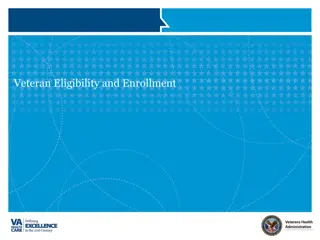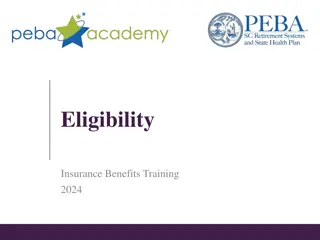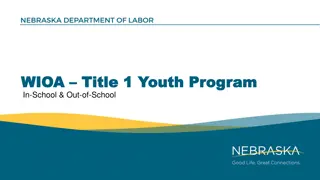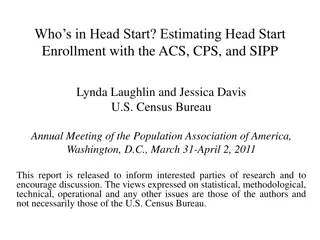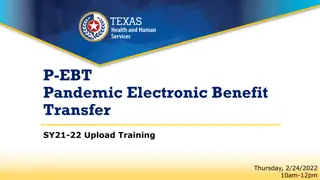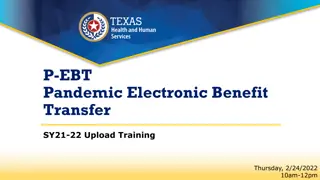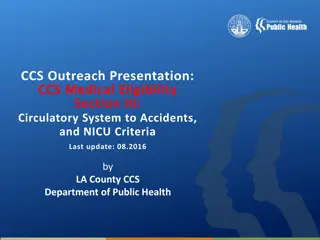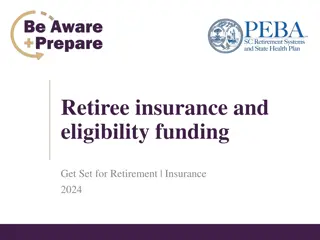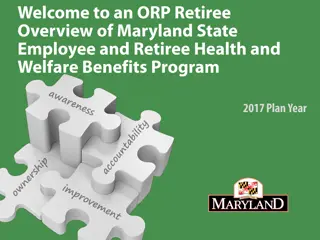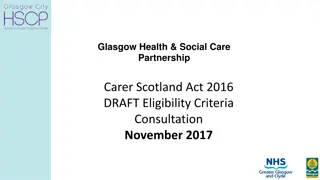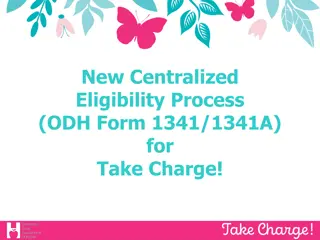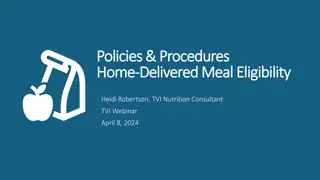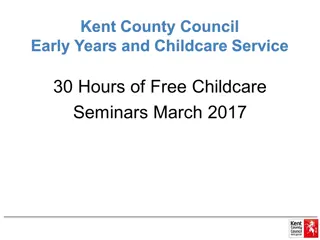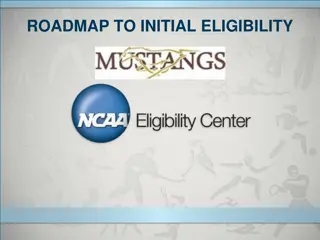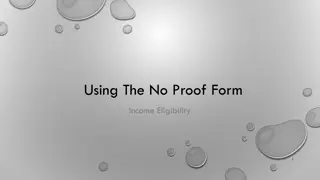Understanding Furlough: Key Steps and Eligibility Criteria
Furlough is a process allowing employers access to the UK Government's Coronavirus Job Retention Scheme, providing financial support to retain employees during the COVID-19 crisis. Eligible entities must meet specific criteria, and employees from various categories can be furloughed. Backdated claims are possible if payroll requirements are met. Learn more about furlough and how to implement it correctly in your business.
Download Presentation

Please find below an Image/Link to download the presentation.
The content on the website is provided AS IS for your information and personal use only. It may not be sold, licensed, or shared on other websites without obtaining consent from the author. Download presentation by click this link. If you encounter any issues during the download, it is possible that the publisher has removed the file from their server.
E N D
Presentation Transcript
FURLOUGH 15 steps to getting it right
1. What is Furlough? Furlough is the process which employers need to put in place in order to be to access the Government s Coronavirus Job Retention Scheme If you cannot maintain your current workforce because your operations have been severely affected by coronavirus (COVID-19), you can furlough employees and apply for a grant that covers 80% of their usual monthly wage costs, up to 2,500 a month, plus the associated Employer National Insurance contributions and pension contributions (up to the level of the minimum automatic enrolment employer pension contribution) on that subsidised furlough pay. This is a temporary scheme in place for 4 months starting from 1 March 2020, but it may be extended if necessary and employers can use this scheme anytime during this period. It is designed to help employers whose operations have been severely affected by coronavirus (COVID-19) to retain their employees and protect the UK economy. However, all employers are eligible to claim under the scheme and the government recognises different businesses will face different impacts from coronavirus.
2. Is your business eligible to claim with the CJRS (Coronavirus Job Retention Scheme)? Who can claim? Any entity with a UK payroll can apply, including businesses, charities, recruitment agencies and public authorities. You must have: created and started a PAYE payroll scheme on or before 19 March 2020 enrolled for PAYE online a UK bank account EXCEPT Where employers receive public funding for staff costs, and that funding is continuing, HMRC expects employers to use that money to continue to pay staff in the usual fashion and correspondingly not furlough them. This also applies to non- public sector employers who receive public funding for staff costs. If you claim while receiving public money for staff costs you are double funding and HMRC will not tolerate this.
3.Who can be furloughed? Any of the following can be put on furlough, whether they work full time or part time: employees workers agency workers those on zero-hours contracts apprentices Employers can also furlough those who are temporarily unable to work because: they're 'shielding' (told to stay at home by the NHS because of an underlying health condition) someone in their household is shielding they have childcare responsibilities they're caring for a vulnerable person in their household
Who can be furloughed? (cont) The furloughed worker must have been on their PAYE payroll and included in a 'Real Time Information' (RTI) submission to HMRC on or before 19 March. Claims can be backdated to 1 March 2020.
4. Putting staff on furlough Employers must select people for furlough in a fair way to avoid any discrimination. They should: Get agreement in writing and be clear how much the employee or worker will get paid during their furlough Keep furloughed workers on the employer's payroll and continue their employment contracts Make sure furlough lasts at least 3 weeks Furlough agreements must be made in writing and kept for 5 years Ensure that your processes are documented, keeping a record of communications to provide a clear audit trail
5. How to select staff for furlough Selecting staff for furlough can be emotional and divisive. Staff that are not furloughed might be resentful of those that are. Equally staff that are furloughed may be fearful of future redundancies. Things to consider: Are all your staff affected? If everyone is furloughed except maybe a CEO or two members of senior staff, then emotions won t run so high. It is for a minimum of 3 weeks, if you need staff back before that time is up then furlough is not suitable. Are certain departments affected more than others? or teams? Or projects? It might make sense to furlough all delivery staff while keeping all admin staff working. Can any roles be combined for a short time? Could finance also cover admin for a while, or can the CEO covers any areas by themselves? Are there any staff members that are volunteering for furlough, they may have caring responsibilities and it might be in both parties interest to furlough that member of staff.
How to select staff for furlough Employees do need to consent to furlough, if they don t then they can t be furloughed. If this happens, these are some of the options: Maintain them in their role on their current terms. Negotiate other ways of reducing costs- maybe reducing hours or more flexible working in order to reduce their gross pay. Suggest the employees takes a period of unpaid leave which they may be reimbursed for later. Start consultation about redundancy. It would be worth getting in professional help if you plan on making staff redundant at this time.
7. You have furloughed your staff, what next? You have selected your staff, communicated with them in writing and they have agreed. Next, agree the date that furlough will begin, it is simplest if this is at the start of a new pay period. Though you can calculate a mixture of non-furlough and furlough days in a pay period. Once on furlough your employee MUST NOT carry out their usual duties nor attend their place of work, or work for organisations linked to the employer until further notice or until: The government s Coronavirus Job Retention Scheme ends. Either the company or the employee ceases to be eligible for funding under that scheme. The company decides to cancel Furlough Leave and bring the employee back to work.
You have furloughed your staff, what next? Employees currently on sick leave and or self-isolation, can only be furloughed once they have returned to work. Employees must be furloughed for a minimum period of 3 weeks. Employees can be furloughed multiple times subject to each furlough period being a minimum of 3 consecutive weeks i.e. they can be furloughed, brought back to work, then re-furloughed. This allows rotating furlough leave amongst employees. Employees will still continue to accrue holiday. Although not working, the terms of employment will continue. Employers can top up wages to 100% and still claim the 80% portion of the salary, the employers NI and employers pension contribution (statutory minimum).
8. What can you claim? Employers can apply for grants to cover 80% of furloughed employees usual monthly wage costs, up to a maximum of 2,500 a month, plus the associated Employer National Insurance contributions and minimum automatic enrolment employer pension contributions on that wage, provided they keep the worker employed. To make a claim go to: https://www.gov.uk/guidance/claim-for-wages-through-the-coronavirus- job-retention-scheme
9. How to claim? To make a claim, you will need: to be registered for PAYE online your UK bank account number and sort code your employer PAYE scheme reference number the number of employees being furloughed each employee s National Insurance number each employee s payroll or employee number (optional) the start date and end date of the claim (at least 3 weeks) the full amount you re claiming for including employer National Insurance contributions and employer minimum pension contributions your phone number and contact name your Corporation Tax unique taxpayer reference (UTR) Gather all of this before you make the claim, you cannot save your progress and stop once you have started.
10.How to work out how much to claim? If possible, before you pay your staff anything, read the HMRC guidance very carefully. https://www.gov.uk/guidance/work-out-80-of-your-employees-wages-to- claim-through-the-coronavirus-job-retention-scheme If you are claiming for an employee who gets paid the same amount each month then you can use the ONLINE CALCULATOR For all other staff you will need to find the right guidance for them and carefully follow the rules. There is guidance and an example for nearly every scenario. You need to be aware that HMRC are calculating furlough days using calendar days and not using working days. So your calculations may differ from HMRC s- this is why it is so important to do the proper calculations before you pay anyone anything as you have to use HMRC calculations for your claim. Your claim has to cover at least three weeks, so may well cover more than one pay period- you will need to add together your pay periods in your claim.
11.Working out the maximum you can claim for each employee The maximum wage amount you can claim is 2,500 a month, or 576.92 a week, plus any National Insurance and pension contributions you can claim for. If the length of time you re claiming for is not one week or one month, you ll need to use the daily maximum wage amounts to work out the maximum amount you can claim for each employee. To work out the maximum amount you can claim, multiply the daily maximum wage amount by the number of days your employee is furloughed for in your claim. Remember it s calendar days, not working days. So in March there were 31 possible furlough days, 30 in April and 31 in May. Daily maximum wage amount March 2020 80.65 per day April 2020 83.34 per day May 2020 80.65 per day
12. Example (Working out 80% of wages for fixed rate full or part time employees on a salary) Where a claim covers multiple pay periods, this calculation should be done for each and then added together. Claim for the 80% of the employee s wages, from their last pay period before 19 March 2020. To work out 80% of your employee s wage: Start with your employee s wages, which is their last pay period before 19 March Divide by the total number of days in the pay period. (31 in March, 30 in April, 31 in March) Multiply by the number of furlough days in the pay period. (including non working days) Multiply by 80%. Example Worker started work for B Ltd in 1997 and is paid a regular monthly salary on the last day of each month. The worker agreed to be placed on furlough from 23 March 2020. The worker was paid 2,400 for the last full monthly pay period before 19 March 2020. There are 9 days between 23 March and 31 March. Start with 2,400 (employee s wages) Divide by 31 (the total number of days in March) Multiply by 9 (the number of furlough days in March) Multiply by 80% - which is 557.42
13. What about NI and Pension Contributions? If you are using the calculator and are paying 80% of wages to your employee for a whole pay period, then the calculator will give you the NI and Penson amounts you can also claim. If you are claiming for a part period, or are topping up to 100% then you will need to calculate NI and Pension contributions separately. Scroll towards the bottom of the guidance and you will find various calculations and examples for NI and Pension contributions. If you are finding it too confusing to work out how much to claim it s worth seeking professional help with your calculations.
14. Collate your claim Do all your calculations nice and clearly in excel, with a separate set of sums for each employee and triple check your calculations against the guidance. Things to check: Have you done calculations for each member of furloughed staff? Have you used the right dates for each staff member- important if some have been furloughed longer than others. You can back date to 1stMarch if need be. Have you calculated the 80% correctly- make sure you use guidance Have you taken into maximum amounts- your claim will be rejected if you try and claim over the 2,500 monthly max ( 576.92 per week). Have you calculated ER NIC and ER Pension payments correctly? This is especially important if you are topping up or are claiming for a part period as earnings threshold will need to be shared out between non furlough and furlough. Your claim start date is the 1stday that your 1stemployee was furloughed. Your claim end date can be upto 14 days after your claim submission. The end of pay period is a sensible end date. Add everything together and you have your claim amount. Make your claim!
15.After you claim As with RTI penalty appeals done through PAYE online there is no confirmation email, you must therefore print the screen with the claim reference number on it as proof that you have made a reclaim in case of queries Reclaims are supposed to be paid within six working days which means that if you need funds by the 30th April for a monthly payroll you will need to make the claim on Thursday 23rd at the latest You must make employees aware that you have made a claim. You need to keep claim records for 5 years Only contact HMRC if you haven t received your money within 10 days. You must pay to your employees all money you are granted through the CJRS, employers cannot deduct any type of admin fee or %. All claims are subject to HMRC audit.
If you need more support or help with claims we can help Call Helen on 07970 495688 or email helen@beeslyconsulting.com



